If you are new to mountain biking you may be wondering what is the difference between mountain biking disciplines because you will find a lot of discussions online around them. As a general rule, there are 5 main types of mountain biking.
XC which means racing on smoother trails with the lightest bike possible, Trail riding allows you to enjoy riding smooth or technical mountain trails, Enduro which are timed downhill rides but you still need to climb the hill, Downhill which focuses only on downhill riding, and Freeride which involves big jumps and tricks.
While these 5 are the main types of mountain biking when it comes to popularity, there are still more mountain biking disciplines that are less well known. In this article, we will analyze them all!
Cross-country Mountain Biking
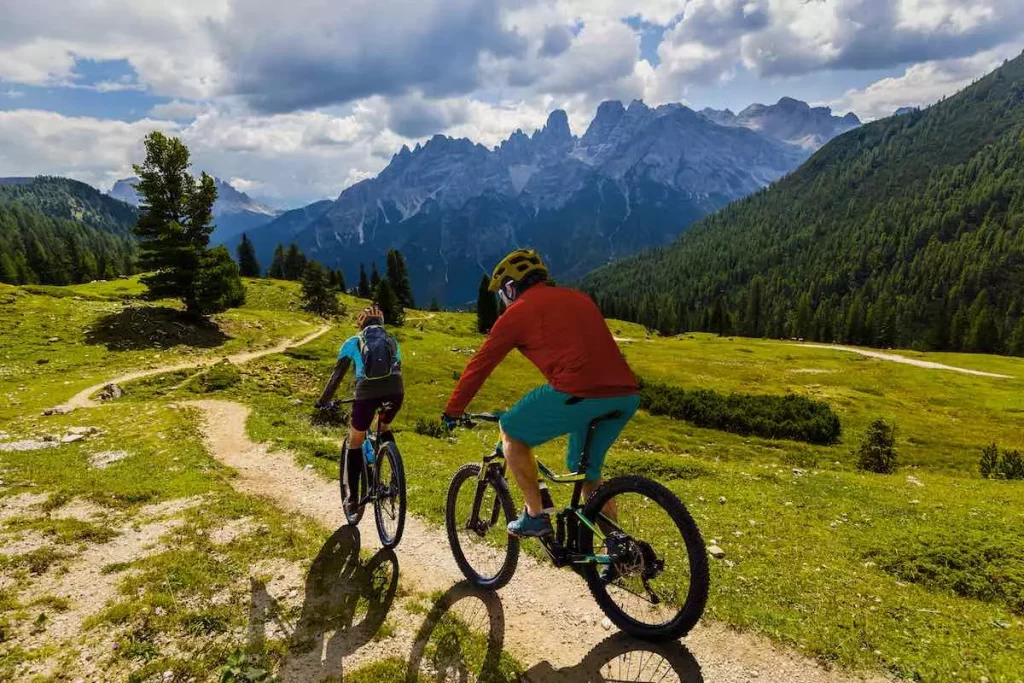
XC mountain biking events are fast and exciting. Racers race against each other over a set course. The races may last as little as 20 minutes for a fun race, or as long as two hours for elite events. Cross-country riding is a popular form of competitive mountain biking and has even gained Olympic status.
XC courses are often made up of a combination of flats and rocky uphills. Course marshals are responsible for marking gear changes so you can pass competitors. Usually, the cross-country trails are smoother than on other mountain biking disciplines and the main focus is speed and pedaling cadence.
But there is more than one XC mountain biking discipline, so let’s explore them all:
- XCM (Cross-country Marathon) – these competitions are focused on long XC rides, some of which are over 100 km (62 miles) long, there is a starting point and a finish point, and the first rider reaching the finish point wins
- XCO (Cross-country Olympics) – these competitions are held on shorter trails 4-10 km (2.4-6 miles) cut the trails are in a close loob format (like a racing circuit) and you need to complete them several times to win (usually last 2 hours or more), the difficulty level can be high and many times riders arrive one or two days earlier to the competition to be able to see the course in advance
- XCC (Cross Country Short Circuit) – this racing format is similar to XCO but a lot shorter, the trails are max 2 km (1.2 miles) long and the length of the race is less than 60 minutes
- XCE (Cross Country Eliminator) – a short multistage race (max 1k or 0.6 miles), 4 to 6 opponents start at the same time but a few of them will qualify in the next stage
- XCP (Point-to-point Cross Country) – this is a competition similar to the XC marathon (the start point is different than the endpoint) but a lot shorter
- XCS (Cross Country Stage Race) – this is an XC race that unfolds in different stages, stages can differ in time and length
| Cross-country characteristics | Description |
| Risk level | Low |
| Minimum skill level required to start | Beginner |
| Fitness level required to start | Low |
| Popularity | Medium |
| Terrain difficulty | Low |
| Adrenaline level | Low |
| Main focus | Petaling efficiency and lower bike weight |
| Cross-country requirements | Recommended |
| Minimum financial commitment | 1000$ |
| Minimum equipment to start | MTB Helmet |
| Type of mountain bike | Hardtail or full suspension |
| Type of MTB brakes | 2 piston hydraulic brakes |
| Minimum suspension travel | 80mm |
Trail riding

Trail Mountain Biking is one of the most popular non-competitive forms of mountain biking similar to cross country but it’s usually more technical with bigger obstacles and you need to overcome more challenging obstacles like rock gardens, big drops, uneven surfaces, and jumps.
Therefore, you should select trails within your comfort level and fit for you. Likewise, you should maintain the bike to its peak mechanical condition.
You can find trails on every skill level, from beginner-friendly trails (green) to veteran black diamond trails. The main advantage here is that you can ride at your own pace and slowly increase the speed when you become better.
| Trail riding characteristics | Description |
| Risk level | Medium |
| Minimum skill level required to start | Beginner |
| Fitness level required to start | Low |
| Popularity | Medium |
| Terrain difficulty | Low-High |
| Adrenaline level | Medium |
| Main focus | Traction and climbing performance |
| Trail riding requirements | Recommended |
| Minimum financial commitment | 3000$ |
| Minimum equipment to start | MTB Helmet, MTB Glasses |
| Type of mountain bike | full suspension |
| Type of MTB brakes | 2 piston hydraulic brakes |
| Minimum suspension travel | 120mm |
All-mountain/Enduro
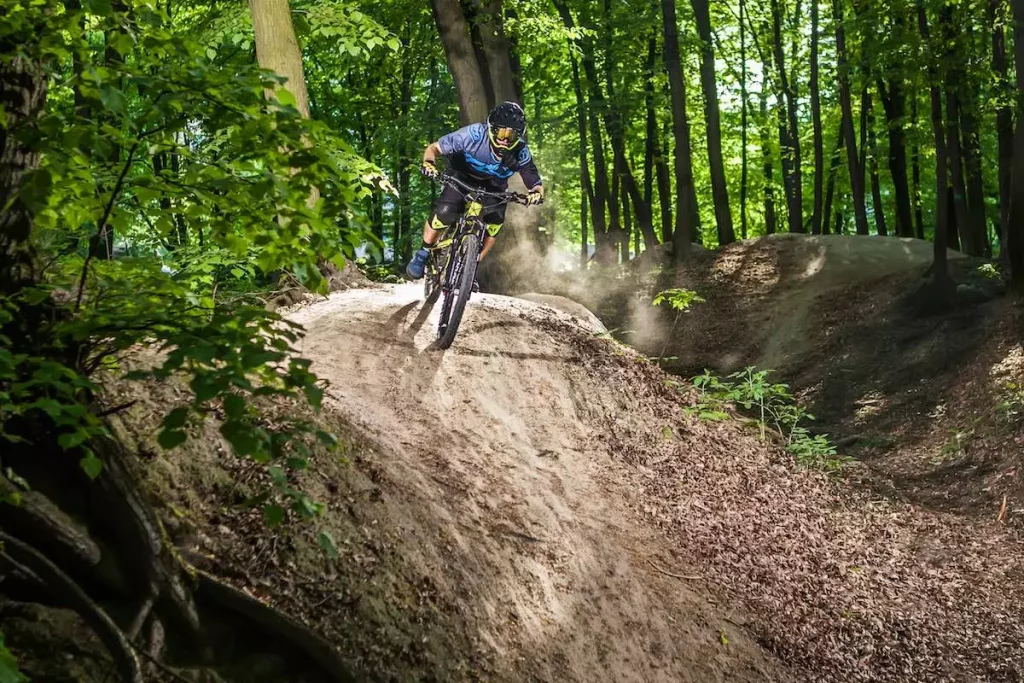
Enduro is a fast and demanding form of mountain biking. Enduro mountain bike races are typically timed and consist of three to six stages. Stages consist of a downhill and an uphill section, but only the downhill section is timed. A lot of riders love the challenge of riding downhill, but this sport can also be frustrating if you’re not prepared.
Practically you need to be at the top of your game when it comes to downhill riding but still be able to climb the hill so you can start the current stage. An Enduro event can last a whole day so your fitness level needs to be well above average.
| Enduro riding characteristics | Description |
| Risk level | High |
| Minimum skill level required to start | Experienced |
| Fitness level required to start | High |
| Popularity | Very high (most popular MTB discipline) |
| Terrain difficulty | High |
| Adrenaline level | High |
| Main focus | Traction and stability |
| Enduro riding requirements | Recommended |
| Minimum financial commitment | 6000$ |
| Minimum equipment to start | Full-face helmet + full set of armored protective gear |
| Type of mountain bike | full suspension |
| Type of MTB brakes | 4-piston hydraulic brakes |
| Minimum suspension travel | 130mm |
Downhill

Downhill mountain biking is a sport for advanced and extreme riders that have perfected their skills and are willing to push themselves to the limit, in competitions, riders tear down gnarly single-track descents with massive drops and gnarly root sections.
The downhill races are very intense and feature only one rider at a time, the rider that completes the course in the fastest time is declared the winner. Downhill mountain biking requires the most skill and the biggest financial commitment, you can’t push yourself to the limit without a well-suited bike (expensive) and the required protective gear.
| Downhill riding characteristics | Description |
| Risk level | High |
| Minimum skill level required to start | Experienced |
| Fitness level required to start | High |
| Popularity | High |
| Terrain difficulty | High to Extreme |
| Adrenaline level | Very High |
| Main focus | Traction and stability |
| Downhill riding requirements | Recommended |
| Minimum financial commitment | 6000$ |
| Minimum equipment to start | Full-face helmet + full set of armored protective gear |
| Type of mountain bike | full suspension |
| Type of MTB brakes | 4-piston hydraulic brakes |
| Minimum suspension travel | 170mm |
Freeride
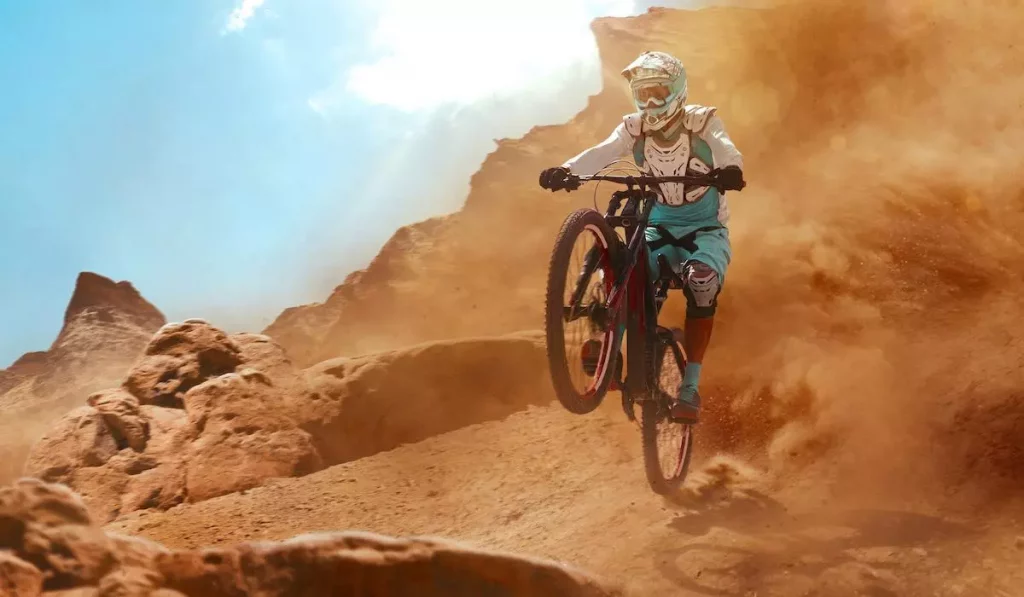
Freeride mountain biking is very similar to downhill mountain biking but here the rider doesn’t have a preset course and the emphasis is on style, amplitude, control, and speed over big obstacles (some are natural and some are man-made).
In freeride mountain biking, the bikers attempt to perform unique tricks and stunts. Much like downhill mountain biking, it focuses on speed and style on difficult trails, it’s a sport that fosters self-expression and pushes the limits of your riding skills.
While being very similar to downhill, freeride trails are much more technical and are filled with bigger jumps.
In freeride mountain biking, the focus is on the biker’s style and trickery, rather than on the trail features.
| Freeride riding characteristics | Description |
| Risk level | Very High |
| Minimum skill level required to start | Veteran |
| Fitness level required to start | High |
| Popularity | Medium |
| Terrain difficulty | High to Extreme |
| Adrenaline level | Very High |
| Main focus | Traction and stability |
| Freeride riding requirements | Recommended |
| Minimum financial commitment | 6000$ |
| Minimum equipment to start | Full-face helmet + full set of armored protective gear |
| Type of mountain bike | full suspension |
| Type of MTB brakes | 4-piston hydraulic brakes |
| Minimum suspension travel | 170mm |
Four-cross/Dual Slalom
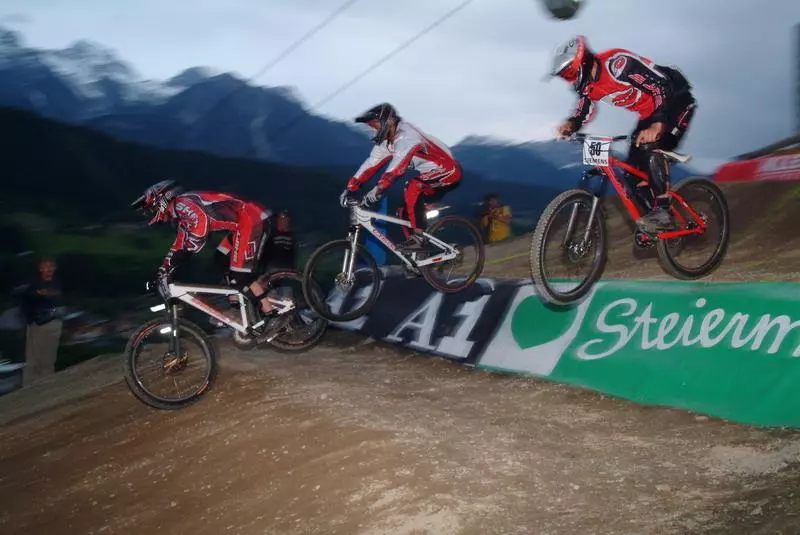
BMX-inspired Four-cross is one of the most spectacular MTB event types, where 4 riders start at the same time and need to ride a short and technical downhill course, this kind of event last for a maximum of 60 seconds and the riders are judged on technical ability, synchronized execution, originality, and flow.
Dual Slalom used to be a to be parallel descent of 2 riders on very similar trails but not this type of event isn’t described anymore in the UFI regulations.
Dirt Jumping
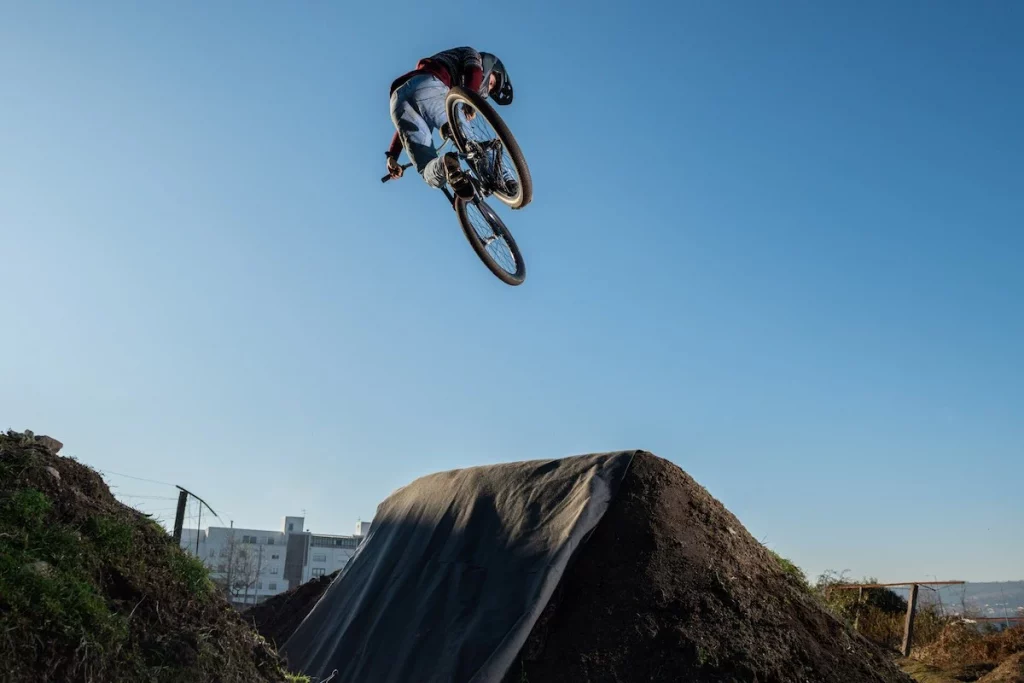
Dirt jumping has its origins in BMX racing, you ride your mountain bike on a special course designed with big ramps and riders perform high-elevation jumps and tricks, choosing the winner is not all about the fastest time but it takes into consideration the style and the difficulty of the tricks performed. These competitions are considered to be a part of extreme sports.
Dirt jump mountain bikes are designed with smaller frames, usually single speed and aren’t the best choice for technical downhill riding, you should use them for what they are designed for, performing styled jumps in specially designed dirt courses.
Trials
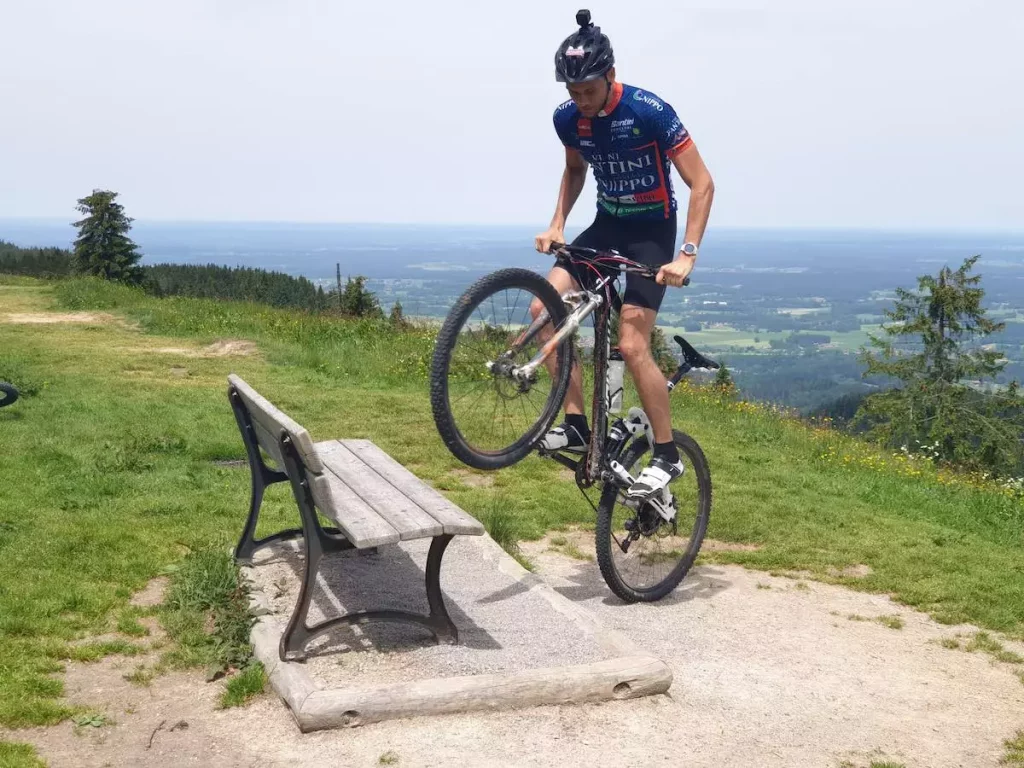
Trials were introduced by Pere Pi, the father of Ot Pi, he wanted his son to learn motorcycle trials while riding a normal bicycle. These events are now held around the world and are very popular, they involve overcoming big obstacles without touching the ground.
Mountain Bike Touring
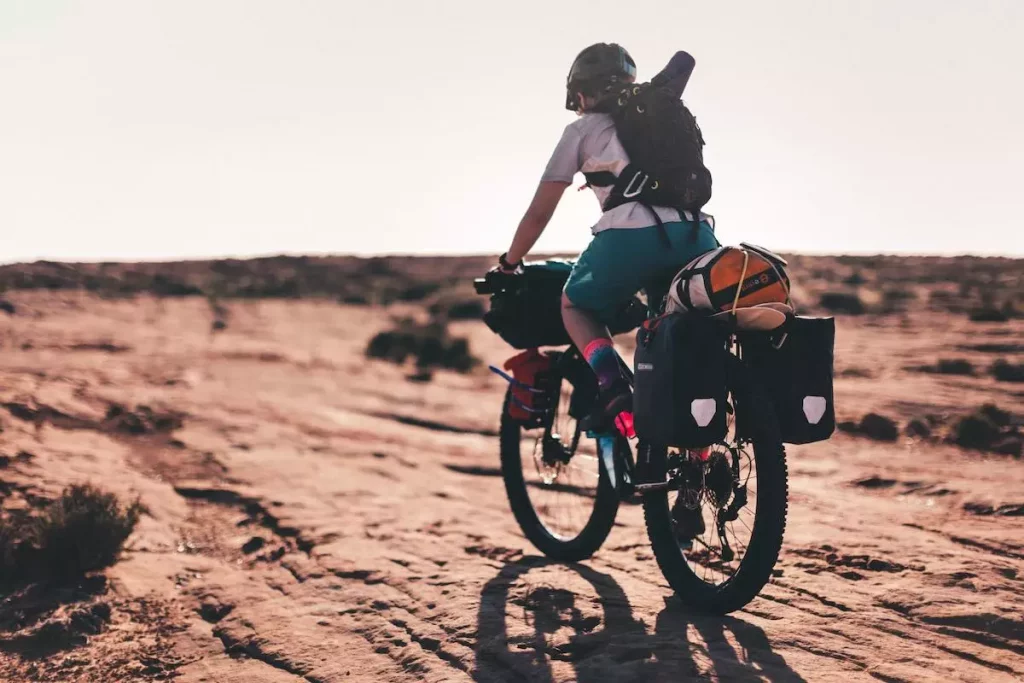
If you’re interested in getting away from it all and exploring the world by bike, mountain biking is the ultimate activity, this is not competitive but it is a great way to explore your surroundings and enjoy very long mountain bike rides with your friends.
Bikepacking
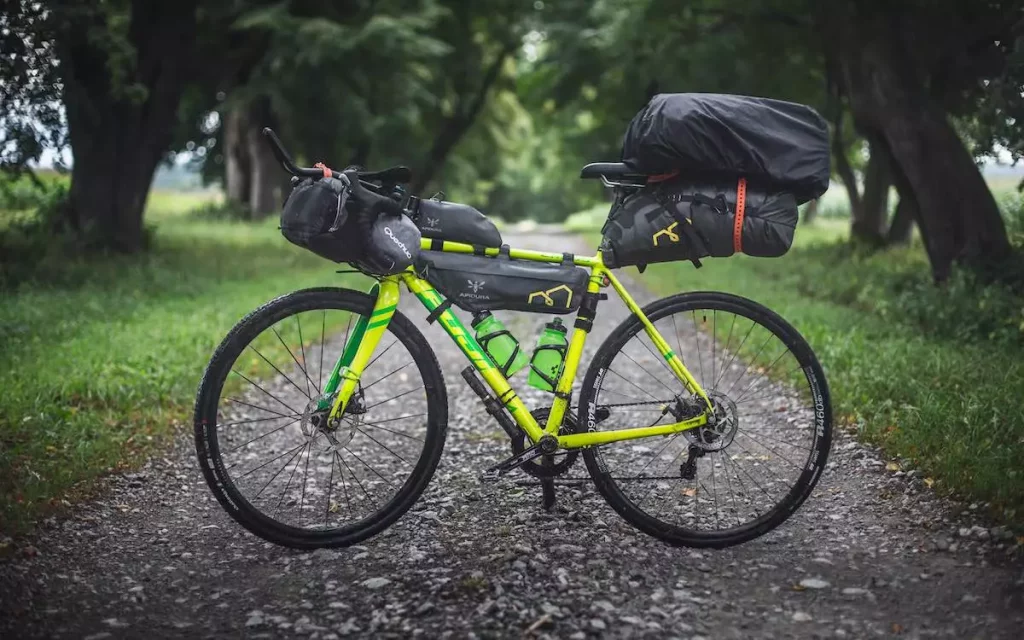
This is very similar to mountain bike touring but is usually focused on exploring nature and multi days rides true tich forests or mountains require you to pack a lot of gear, the main focus here is how can you pack in the most efficient way possible all the gear you need to camp in nature and successfully ride on rough terrain as many days as possible.
Final thoughts
Now you practically know all the mountain biking disciplines that are worth mentioning so you can choose which riding style is for you.
The most popular mountain biking discipline is Enduro because it is very challenging and the downhill portions will really make your heart pump faster.
Knowing your preferred riding style is very important because it helps you to determine what is the correct type of mountain bike for you.
Related articles:
I started mountain biking many years ago to improve my overall health state. After my first ride, I fell in love with the sport. Now I spend dozens of hours a week researching and training to compete in local XC and Enduro events.

